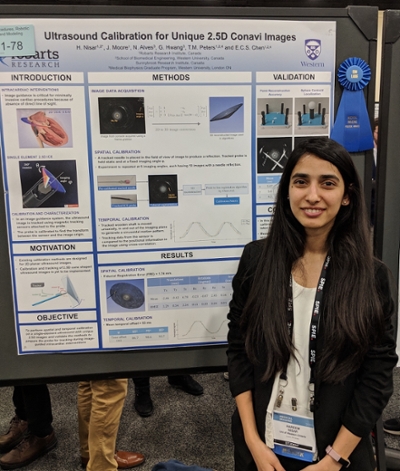Hareem Nissar wins best poster at SPIE Medical Imaging conference
 Congratulations Hareem Nissar, Biomedical Engineering PhD student, for winning best poster award at the SPIE Medical Imaging conference in the Image-Guided Procedures, Robotic Interventions, and Modelling category!
Congratulations Hareem Nissar, Biomedical Engineering PhD student, for winning best poster award at the SPIE Medical Imaging conference in the Image-Guided Procedures, Robotic Interventions, and Modelling category!
Nissar represented Western at the conference in San Diego, Calif., February 16-21. Her poster was based on the project called "Ultrasound Calibration for Unique 2.5D Conical Images."
Nissar's research is centred on improving image-guided cardiac surgeries. Trends in cardiology have shifted from open heart surgery to interventional cardiology. Instead of cutting the chest open and putting the patients on the heart-lung machine, the surgeon now creates a small incision in the leg and accesses the heart through the veins. Although such interventional surgeries greatly reduce the risks involved with traditional surgeries, the surgeon loses the direct line of sight of the heart anatomy. Image-guided systems help visualize patient anatomy and tool positioning in real time in a virtual environment. Such as, the patient anatomy is seen using ultrasound and the surgery is performed using specially designed tools. By tracking both the ultrasound and the tools and creating a virtual representation on a screen, the surgeons are able to perform the surgical intervention with safety and more confidence. Ultrasounds can easily be tracked by placing an electromagnetic sensor on the imaging probe. However, Nissar is interested in the location of the image and not the probe itself. The process of finding the physical transform/relationship between the sensor on the probe and the origin of the image is called calibration.
Intracardiac ultrasounds (ICE) are thin long ultrasound probes that can enter the heart through the veins during an intervention. Ultrasound probes usually have multiple transducers elements which act as cameras to form the image. Foresight ICE is a new intracardiac ultrasound by Conavi Medical - a start-up company based in Toronto. Foresight ICE only has one transducer element which rotates mechanically to generate a hollow cone-shaped image. The imaging data lies in a 3D space but along the cone surface (2D), which is why this unique image geometry is referred to as 2.5D.
Calibration techniques in the literature are designed for 2D planar images. Hareem extended and designed a calibration method to work for the unique cone-shaped images. She is using methods by Chen et al and D.Gobbi and extending them to work for her unique 2.5D images.
Nissar is supervised by Terry Peters. The project was co-advised by Elvis Chen.
Great work, Hareem!






